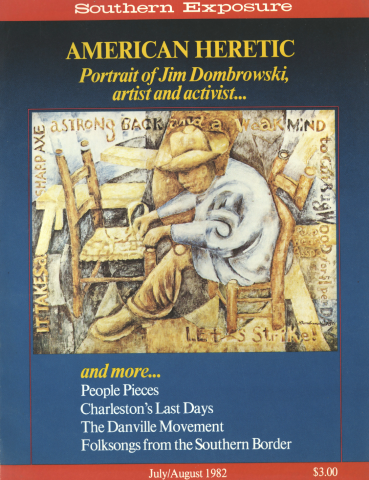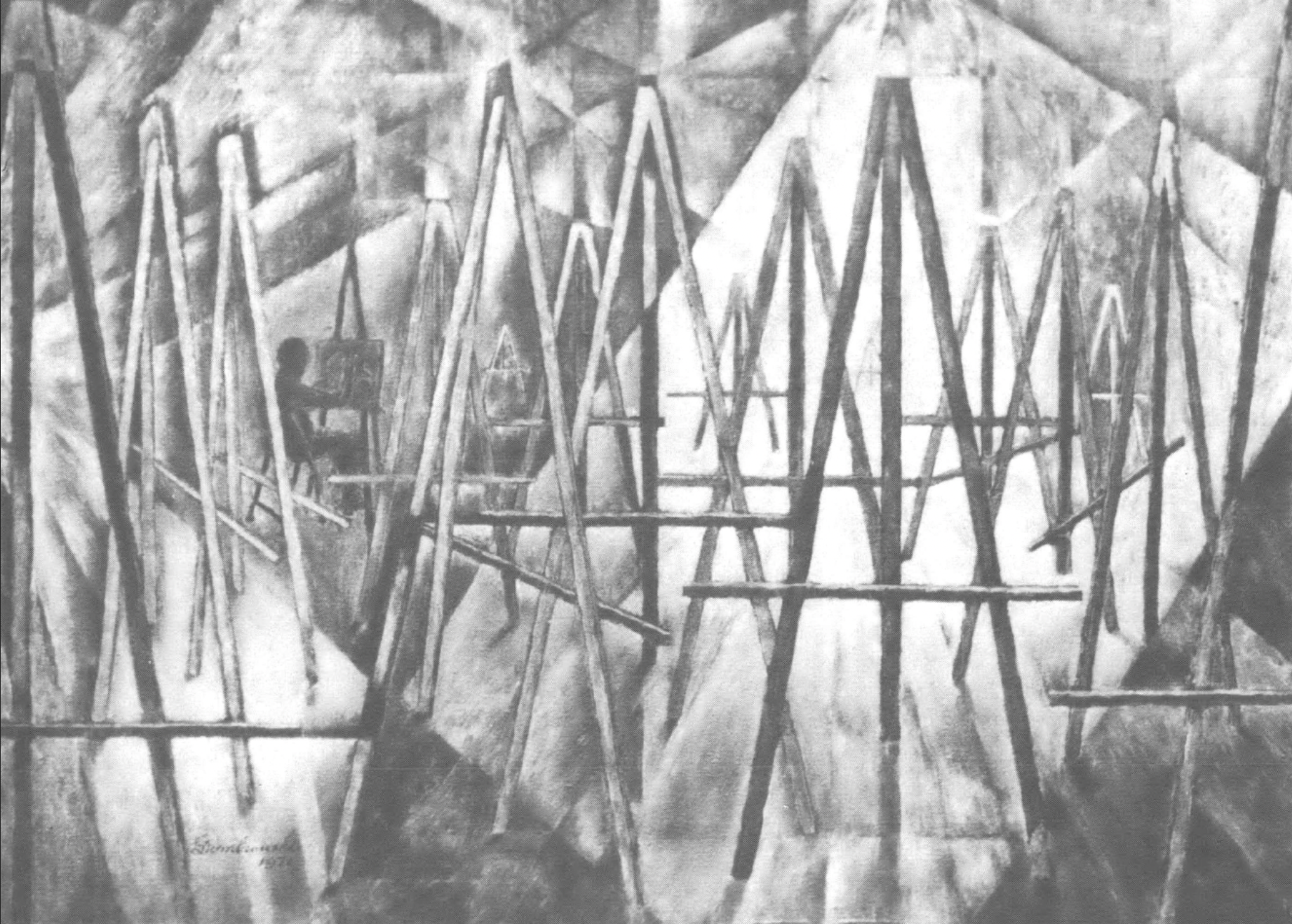
This article originally appeared in Southern Exposure Vol. 10 No. 4, "American Heretic: Portrait of Jim Dombrowski, artist and activist." Find more from that issue here.
JIM DOMBROWSKI, I am one of the many who CELEBRATE . . . YOUR EXISTENCE. In your ways of speaking and reminding and sheltering and nurturing I am addressed, taken into a deeper stream of humanness myself, and made more able and strong to offer shelter and food to others and to speak against human injustices.
Of your Declarations I can also witness: THE MACHINE HAS NOT WON.
In one way or another, the South has known of Jim Dombrowski these last five decades. In the 1950s, Senator Joe McCarthy and his ilk knew of Jim, were angered by him, hunted him down, had him on trial. But it was the Southern poor people, the disenfranchised Americans, who knew him best. Almost to a person, they praised Jim Dombrowski, but not in money or words. They praised him by finding hope; not by merely suffering and existing, but by building a new life, persisting in hard work and honest hope — made believable and rigorous in their knowing (of) Jim.
To visit Jim nowadays is to visit a deliciously softspoken Southern 24 gentle man, a man of great forbearance and simple dignity whose hobby is painting and drawing-from-life.
Jim has been doing art for most of his adult life, but never had the time to let it be central in his living of life . . . until retirement and widowerhood came. Thus during his seventh decade, Jim made art! Made his visual records of his seeing, hearing, tasting, watching, thinking about, and being a full participant in our human engagement with Time, and anticipating the Future. That's how I see his paintings, his sketches, his drawings and especially the annual exhibitions of his which have been held in New Orleans for nearly a decade.
SELF PORTRAIT
This self-portrait reveals to me Jim's gentle-robust humor. His strong sense of design is noticeable first. The painting asserts rhythm and balance even as he moves us toward the abstract in spatial sequences. Yet, there, in the background distance, "lost in the painting," is a man's figure. Jim. Very much a Self portrait.
INVITATION TO FIFTH ART DISTRIBUTION
Friends of Jim's in all parts of the country received this invitation in their mail in November, 1978 . . . and on the back of the invitation another printed-by-machine bit of his handwriting: THE PROCEDURES . . . for the works' distribution to guests. All the people the house would hold came to the exhibition, and all who came went home with an original work of art, signed, dated, and freshly cleaned and framed for this exhibit. The EXHIBIT is, in fact, an annual art distribution of approximately 100 works of Jim's making, on loan for one year with no money to pay out for this rare privilege of having an original art work, living with it as it lives with YOU throughout the coming-year with all its hopes and sorrows.
No one seems to have realized what Jim realized in his devising of this way of sharing art: that it is not Art which is sacred; it is, rather, the EXPERIENCE of what art is about that is sacred. To nourish this is a complex matter, yet Jim has found a way that is equitable, compassionate, and at the very center of WHAT ART IS FOR: to share the sacred of life.
SHRIMP BOATS, NEW ORLEANS and STILL LIFE WITH SHOE TREES
In Shrimp Boats, the sky, though it doesn't "churn" or threaten, looks restlessly alive and the boats are people-less, at their rest, implied, not shown. In these decidedly post-industrial-revolution times, it is in his New Orleans theme that Jim shows his understanding of Detroit . . . of the human caught in the machine . . . but notice! not itself deformed . . . that painted telephone in Still Life with Shoe Trees implies a voice, a human conversation with a friend, a voice with its almost non-stop yak-yak, and over it as a poised "hand" hovering as if in blessing over the "talking machine," and then the gentle-alive semicircular arabesques-in-no-hurry phone stand. . . . The machine has not won.
STILL LIFE WITH COFFEE POT
A watercolor of a cup and saucer, a sterno coffee pot, an unlit candle (dynamite stick?), resting on the front page of a newspaper called: 15 cents DAILY WORLD, headlining MEAT BOYCOTT . . . and then on the other side of the coffee pot: NIXON, and in the lower right hand corner of the painting Jim has signed with his JAD monogram and the year, 1973.
It's all there . . . you may read it. . . the coupon world is implied to us, perhaps the worker's world, the homemaker's, the old ones' . . . resting on the news of the world today . . . 15 cents worth. Below the NIXON, resting on the table top over which is the newspaper, is a lone candle . . . yet unlit, no flame. Potential implied. A lone candle, Christian iconography tells us, is THE EYE OF GOD, the single eye of God. As in God With Us. Potentially! This is the real dynamite. There Jim records the potential of God With Us, as we learn the news of the day, worth 15 cents of our hard-earned pay . . . in the cotton mill, the auto repair shop, the meat counter of a Publix. Jim knows these conditions —all through his experience and life, and he is sharing now in this way that we too might see and understand.
LET'S STRIKE and MADRE PUERTORRIQUENA Y SUS NINOS
The oil painting entitled It takes a sharp axe, a strong back and a weak mind to cut bug wood at a dollar a day. Let's strike! is powerful in both revealed and hidden ways, and in this respect it is like Madre Puertorriquena y sus ninos, also in oil. Dombrowski wants to show the real life of people in the small crowded corners of the society; the worried and tired mother with two small children. The little boy in the foreground pushes against his mother's dress, and the pattern of the dress-folds suggests a candelabra of six or perhaps seven branches. The thorny yucca plants in bloom are sharp and relentless against the hill country and emit vibrations of life beneath the surface: harsh realities meeting human needs, the growth necessary to human life against the stubborn existence of the tough plant seen growing and blooming in the background.
For me this painting adds meaning to a recent event in Puerto Rico, with its menacing presence of the U.S. Navy at Vieques Island. The Puertorriquenos, after nearly a decade of having to lock their women in, away from the carnal menaces of the off-duty Navy men, at last chose a spokesperson and protested. The Navy spokesperson replied to the fishers that they need not trouble to lock the women away each evening. The Navy "boys" were only lonely and restless and "wanted a woman." After all, the women would not be in any danger of pregnancy, for the U.S. medical men had already been able to sterilize these women — at least those they had taken in for any sort of medical treatment.
The U.S. Navy itself does not realize the quality of Wholeness that is being violated, and that is what Jim Dombrowski's very life is ABOUT . . . making awareness and calling sensitivity into being: as a long-ago mission minister, as an organizer in the South among the poor, as a worker among workers, and in courtrooms of the HUAC era, and now as a visual artist . . . hoping, trusting and working: for the nurturing of human sensitivities and towards wholeness.
Tags
Margaret Rigg
Margaret Rigg, assemblage artist and calligrapher, is a professor of visual art at Eckerd College, Florida. Her work is on display in many museums and galleries, from the Smithsonian Institution to Emille Museum in Seoul, Korea. (1982)

